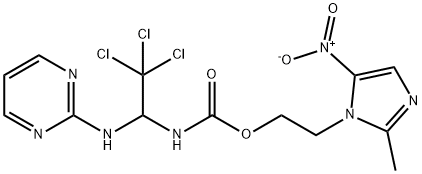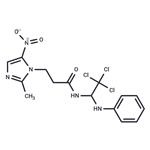Biochem/physiol Actions
Apcin is an inhibitor of the anaphase-promoting complex/cyclosome (APC/C), a large multimeric complex that functions as a ubiquitin ligase, initiating the metaphase–anaphase transition and regulating ordered transitions through the cell cycle by controlling the ubiquitin-mediated proteolysis of cell cycle proteins. Apcin prevents substrate recognition and inhibits APC/C-dependent ubiquitylation by binding to the D-box binding site of Cdc20, a coactivator required for full activation of APC/C and substrate recognition. The effectiveness of apcin in blocking mitotic exit was synergistically amplified by co-addition of TAME (tosyl-L-arginine methyl ester) or its cell permeable prodrug proTAME, which block Cdc20 binding to the APC/C at a different site than apcin.
Enzyme inhibitor
This Cdc20 inhibitor (FW = 438.65 g/mol; CAS 300815-04-7; Solubility: 100 mM in DMSO), also named 3-(2-methyl-5-nitroimidazol-1-yl)-N- (2,2,2-trichloro-1-phenylaminoethyl)propionamide, targets substrate interaction of Cell division control protein 20, blocking substrate-mediated Cdc20 loading onto the Anaphase-Promoting Complex. APC is a 13- subunit ubiquitin ligase that initiates the metaphase-anaphase transition and mitotic exit by targeting proteins such as securin and cyclin B1 for ubiquitin-dependent destruction by the proteasome. APC regulates cell cycle progression by forming APC·Cdc20 and APC·Cdh1, two closely related, but functionally distinct, E3 ubiquitin ligase sub-complexes. Cdh1 and Cdc20 have opposing functions in tumorigenesis, with the former largely functioning as a tumor suppressor, and the latter exhibiting an oncogenic function. Because blocking mitotic exit is an effective approach for inducing tumour cell death, the APC/C represents a potential novel target for cancer therapy. APC/C activation during mitosis requires Cdc20binding, forming a co-receptor with the APC/C to recognize substrates containing a destruction box (D-box). APC/C-dependent proteolysis and mitotic exit can be synergistically inhibited by simultaneously disrupting two protein-protein interactions within the APC/C-Cdc20-substrate ternary complex. APC inhibitor, or Apcin, binds to Cdc20, competitively inhibiting ubiquitylation of D-box-containing substrates. Analysis of the crystal structure of the apcin-Cdc20 complex suggests that apcin occupies the D-box-binding pocket on the side face of the WD40-domain. The ability of Apcin to block mitotic exit is enhanced by co-addition of tosyl-l-arginine methyl ester (See TAME), a small molecule that blocks the APC/C-Cdc20 interaction. Apcin also inhibits APC-dependent ubiquitylation and prolongs mitotic duration in RPE1 cells, when administered in combination with proTAME, a prodrug of TAME in vitro (See pro-TAME).


